Choosing your first bass guitar can be overwhelming. The market is flooded with options, and sifting through biased reviews or opinions from inexperienced players can be frustrating. At guitarplayers.net, we cut through the noise. Our reviews are built on rigorous, no-nonsense testing, and we’re here to guide you to the best beginner bass.
How do we ensure unbiased recommendations? We conducted a blindfolded shootout featuring professional bassists. No brand favoritism, no preconceived notions – just honest assessments you can rely on.
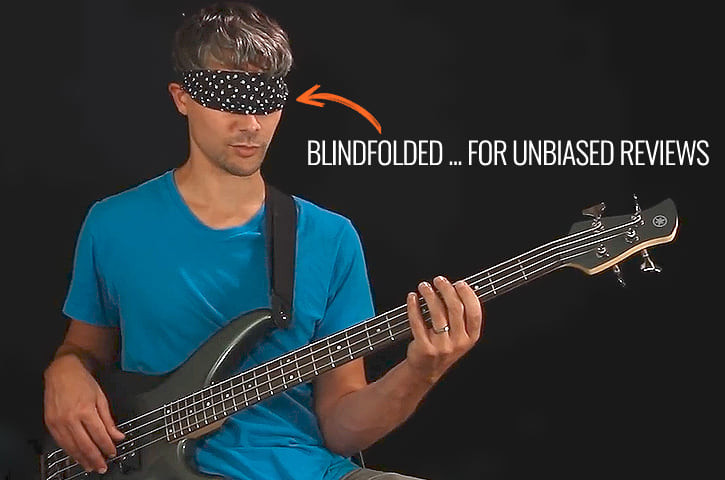 Three professional bass players blindfolded, testing bass guitars. Blindfolded Professional Bassists Conducting a Bass Guitar Review
Three professional bass players blindfolded, testing bass guitars. Blindfolded Professional Bassists Conducting a Bass Guitar Review
Quick Navigation
Want to skip to specific sections?
Our Review Process: Selecting the Best Beginner Bass Guitars
Identifying the Contenders
Our journey began with an extensive online search, cataloging every bass guitar under $500 we could find. This initial list ballooned to approximately 200 basses. Yes, you read that right – 200!
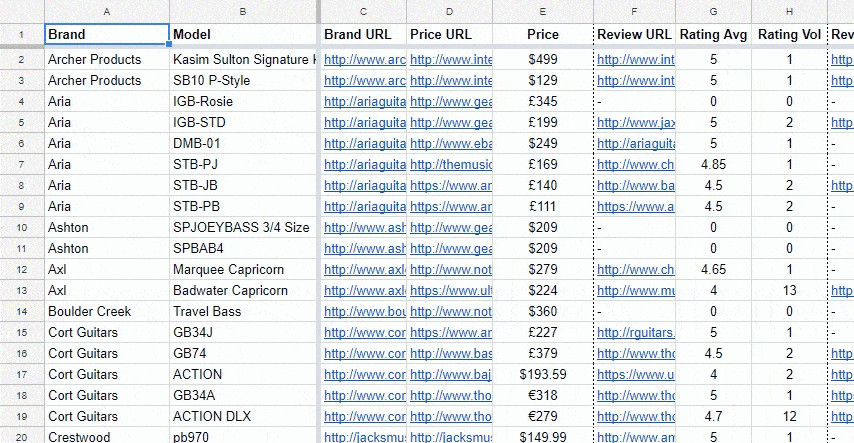 Spreadsheet showing a large list of bass guitars being considered for review. Initial Selection Spreadsheet of Bass Guitars
Spreadsheet showing a large list of bass guitars being considered for review. Initial Selection Spreadsheet of Bass Guitars
To narrow down this massive list to a manageable set of contenders for our shootout, we implemented a strict filtering process:
1. Reputable Brands Only. We prioritized basses from established companies with proven track records and readily available reviews. For beginners, sticking to well-known brands minimizes risk and ensures a degree of quality.
 Close-up of a bass guitar headstock showcasing brand reputation and build quality. Focusing on Build Quality and Brand Reputation for Beginner Basses
Close-up of a bass guitar headstock showcasing brand reputation and build quality. Focusing on Build Quality and Brand Reputation for Beginner Basses
2. Four-String Configuration. We focused exclusively on four-string basses. For beginners, a four-string bass offers a simpler learning curve, allowing you to master the fundamentals before potentially exploring five or six-string models later.
 A standard four-string bass guitar, highlighting its suitability for beginners. Four-String Bass Guitars are Ideal for Beginners
A standard four-string bass guitar, highlighting its suitability for beginners. Four-String Bass Guitars are Ideal for Beginners
3. Standard Scale Length. The majority of our selections featured a standard 34” scale length (with one exception at 35”), the most common and versatile scale for most players. Players with smaller hands might consider short-scale basses, which we plan to review in the future.
 A standard four-string bass guitar, highlighting its suitability for beginners. Standard Scale Length Bass for Comfortable Playing
A standard four-string bass guitar, highlighting its suitability for beginners. Standard Scale Length Bass for Comfortable Playing
4. Dual Pickup Configuration. We limited our selection to basses equipped with two pickups. While single-pickup basses have their place, dual-pickup models provide greater tonal flexibility, allowing beginners to experiment and discover their preferred sound across various musical genres.
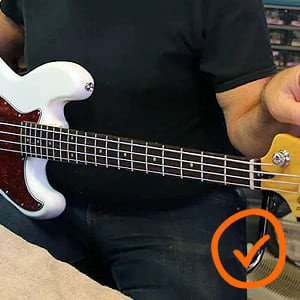 Close-up of a two-pickup bass guitar, emphasizing tonal versatility. Two Pickups Offer Greater Tonal Options for Beginner Bassists
Close-up of a two-pickup bass guitar, emphasizing tonal versatility. Two Pickups Offer Greater Tonal Options for Beginner Bassists
Even after these criteria, we still had too many potential basses. We further refined the list by considering existing reviews, brand popularity, reputation, and leveraging our professional intuition to arrive at a final shortlist of seven basses for our blind shootout.
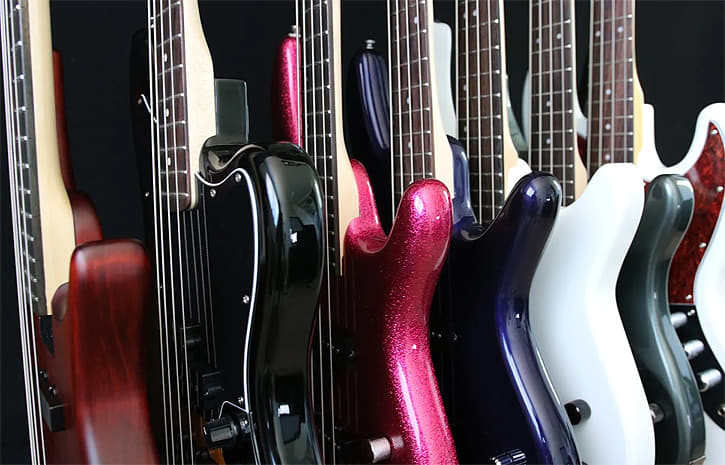 The seven bass guitar contenders lined up for the blind test review. The Seven Bass Guitar Contenders for the Blind Shootout
The seven bass guitar contenders lined up for the blind test review. The Seven Bass Guitar Contenders for the Blind Shootout
Our No-Nonsense Blind Review Methodology
To eliminate personal bias as much as possible, we implemented a blind review process. Two experienced bass-playing colleagues were blindfolded, ensuring they were unaware of the specific bass they were playing until the review’s conclusion. All three reviewers possess extensive experience across diverse musical styles, providing a well-rounded perspective for judging tone and feel across different instruments.
 Professional bassist Gio Benedetti, one of the blind test reviewers. Pro Reviewer Gio Benedetti, Contributing Expertise to the Blind Bass Review
Professional bassist Gio Benedetti, one of the blind test reviewers. Pro Reviewer Gio Benedetti, Contributing Expertise to the Blind Bass Review
 Professional bassist Ben Burleigh, participating as a blind test reviewer. Pro Reviewer Ben Burleigh, Providing Honest Feedback in the Blind Bass Test
Professional bassist Ben Burleigh, participating as a blind test reviewer. Pro Reviewer Ben Burleigh, Providing Honest Feedback in the Blind Bass Test
Our approach was driven by genuine curiosity and a commitment to delivering the most reliable recommendations for beginner bassists. We maintain complete independence from the brands we reviewed and instructed our reviewers to provide completely candid and unbiased assessments.
To ensure an even playing field, all seven basses were taken to our trusted bass technician, Kent Fossgreen, a renowned instrument repair expert in our area. He conducted a thorough inspection of the construction quality and factory setup of each bass.
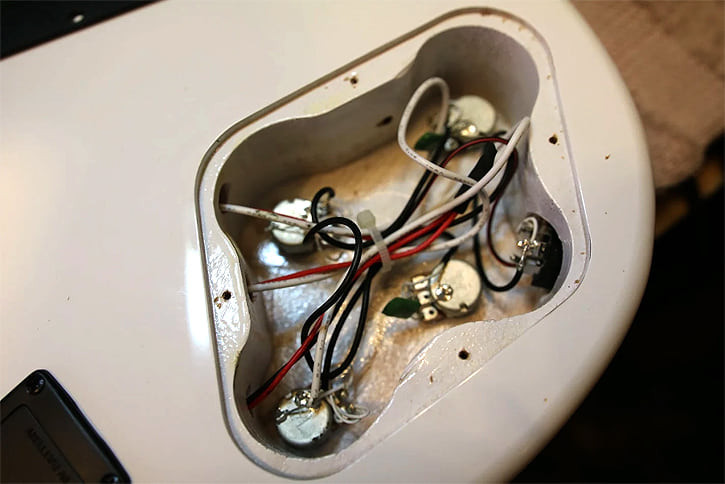 Kent Fossgreen, bass technician, inspecting the build quality of the beginner basses. Build Quality Inspection by Experienced Bass Technician Kent
Kent Fossgreen, bass technician, inspecting the build quality of the beginner basses. Build Quality Inspection by Experienced Bass Technician Kent
Kent then replaced the factory strings on all basses with brand new strings and performed setups to eliminate any setup inconsistencies that might influence the reviewers’ evaluations.
During the blind review session, all basses were played through the same amplifier – a TC Electronic RH450 with an RS210 cabinet – using flat EQ settings. This ensured that the only tonal adjustments were made directly on the basses themselves.
For audio recording during the video reviews, each bass was recorded directly into an Audient iD14 digital audio interface and into Logic Pro. To capture the purest “dry” sound of each instrument, no compression or EQ was applied at any point during recording. It’s important to note that this is not typical bass recording practice, and all these basses would generally sound even better with standard signal processing.
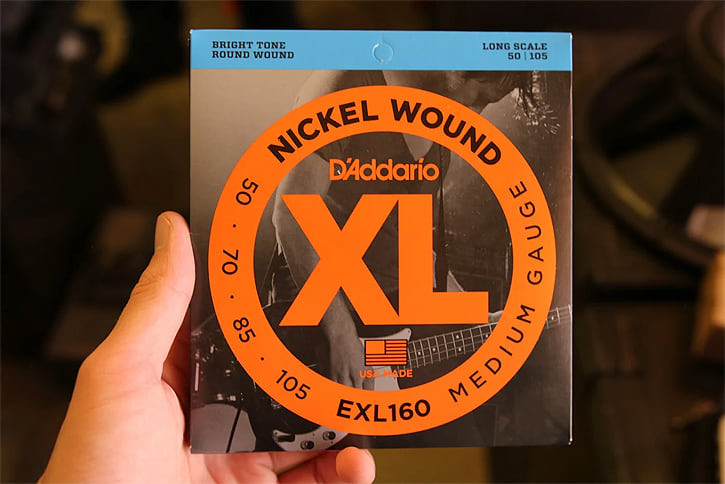 New strings being installed on all basses for a fair and consistent review. Consistent Strings Used Across All Basses for Objective Testing
New strings being installed on all basses for a fair and consistent review. Consistent Strings Used Across All Basses for Objective Testing
Rating Criteria for Beginner Bass Guitars
Our reviewers assessed each bass based on four key criteria: Playability, Tone, Comfort, and Versatility. These criteria were explained to the blindfolded reviewers as follows:
1. Playability. This focused primarily on the bass neck – evaluating the comfort of movement along the fretboard, string spacing, access to upper frets, string tension, and any noticeable issues like sharp fret edges or dead spots.
2. Tone. Reviewers explored the tonal possibilities using standard fingerstyle technique and adjusting the onboard controls. This rating reflected the overall sonic impression of the instrument, the perceived quality of the pickups and electronics, and whether the bass would be suitable for live performance.
3. Comfort. This criterion held the least weight in the overall score. Reviewers assessed the bass’s feel against their body in terms of weight and balance.
4. Versatility. Reviewers tested various playing techniques, including picking and slapping, to assess the physical comfort of these techniques and the bass’s ability to produce pleasing tones across different styles.
While our technician assessed construction quality, any minor issues were not factored into the scoring, as none of the basses exhibited significant flaws. However, notable technical observations are included in the “Tech Corner” section for each bass.
The final overall rating for each bass represents the average of all three reviewers’ scores.
General Technical Observations
All basses arrived in good condition with playable setups. Our technician, Kent, noted regarding setup and quality control: “You could confidently buy any of these basses online.” Basses manufactured in Indonesia generally had slightly higher setups than those from China, but all were playable right out of the box.
 Bass technician Kent discussing general tech notes and observations. Bass Tech Kent Sharing Insights on Beginner Bass Quality
Bass technician Kent discussing general tech notes and observations. Bass Tech Kent Sharing Insights on Beginner Bass Quality
A common issue observed was loose tuner bushings on basses with closed gear tuners. These likely were only hand-tightened at the factory, possibly intentionally to prevent damage during shipping. It’s important for new owners to be aware of this and tighten these bushings with a hex wrench upon receiving their bass to prevent tuner instability or failure.
Epiphone/Tobias Toby Deluxe IV Review
Price: $229
| Feature | Rating |
|---|---|
| Playability | 80% |
| Tone | 50% |
| Comfort | 60% |
| Versatility | 60% |
★★☆☆☆
VERDICT: Does this bass live up to the legacy of Michael Tobias? In our opinion, not entirely. While it excels at aggressive rock tones, it falls short for other genres. If you’re seeking versatility, you might want to explore other options.
Epiphone/Tobias Toby Deluxe IV: Detailed Review
The Epiphone/Tobias Toby Deluxe IV carries a name with significant weight in the bass world. Michael Tobias, a highly respected bass luthier, collaborated with Gibson/Epiphone in the early 1990s before establishing his independent brand, MTD (Michael Tobias Design). While Tobias no longer designs for Epiphone, Gibson retains the “Tobias” name.
This bass is designed in the spirit of Michael Tobias’s instruments, raising our expectations, having experienced some of his high-end custom creations. Let’s see if this beginner-friendly model lives up to the Tobias name.
Tech Corner
This bass required slightly more setup work than others in the lineup but adjusted well. The 9V battery powering the active EQ was housed in a clip within the main control cavity, rather than a dedicated compartment. Unfortunately, the battery had dislodged during shipping, causing rattling within the bass body.
Playability: 8/10
The 24-fret neck is a definite plus, providing easy access to higher registers. While the neck profile is slightly thicker than my personal preference, it remains comfortable. The string spacing is a bit wider than I typically need, but this could be advantageous for beginners developing their fingerstyle technique.
Tone: 5/10
The Toby Deluxe IV’s inherent tone leans towards thinness, with a pronounced high-end emphasis from the tone control. Achieving desirable tones often necessitates engaging the active bass boost, which isn’t ideal – I prefer a bass that sounds good even without relying on active circuitry. However, the bass boost circuit itself was the most appealing among all basses tested, offering a focused and punchy low-end enhancement. My preferred tones were achieved with the tone control maximized and bass boost engaged, delivering solid aggressive rock sounds. However, achieving a satisfying “quacky” funk tone proved elusive, as the bridge pickup exhibited a brittle character I found unappealing.
Comfort: 6/10
The weight distribution and overall weight were comfortable for all reviewers. Neck balance was also well-maintained.
Versatility: 6/10
Slap bass technique presented a significant issue for me due to the bridge design. The bridge protruded in a way that uncomfortably dug into my forearm. While this may not affect all players depending on arm length and technique, it personally eliminates this bass as an option for slap-style playing. Ben and Gio did not encounter this bridge issue and found the slap tones more enjoyable than I did.
Specs
| Feature | Specification |
|---|---|
| Manufacturer | Epiphone |
| Series | Toby |
| Model | Toby Deluxe IV |
| Manufacturer Website | Epiphone Toby Deluxe IV Product Page |
| Price | $229 |
| Active/Passive | Active (bass boost) |
| Scale Length | 34″ |
| Weight | 7.8lb / 3.54kg |
| Number of Frets | 24 |
| Body Wood | Radiata |
| Neck Wood | Hard maple |
| Fingerboard Wood | Rosewood |
| Fingerboard Radius | 12″ |
| Pickups | Tobias TBR™ Dual Rail Humbucker x2 |
| Controls | Master volume, Pickup blend, Passive tone, Active bass boost |
Snapshots
Bass guitar Epiphone Toby Deluxe IV angled body shot.
Bass guitar Epiphone Toby Deluxe IV headstock and neck shot.
Bass guitar Epiphone Toby Deluxe IV full body shot.
Squier Vintage Modified Jaguar Bass Review
Price: $249
| Feature | Rating |
|---|---|
| Playability | 70% |
| Tone | 60% |
| Comfort | 50% |
| Versatility | 70% |
★★★☆☆
VERDICT: Squier generally produces solid entry-level instruments, but this Jaguar model has a couple of noteworthy drawbacks. Gio aptly described the active bass boost as a potentially problematic “doom knob” if used carelessly in a live setting. I concur.
Reviewer opinions on this bass were quite varied. Gio favored it more than Ben and I, potentially due to his familiarity with higher-end Fender Jaguars, making this Squier feel more comfortable and familiar to him.
While not the worst beginner bass choice, we encourage exploring further to see if we can identify superior options.
Squier Vintage Modified Jaguar Bass: Detailed Review
Squier, Fender’s budget-friendly instrument line, has long been a staple in the beginner bass market. Having played higher-end Fender Jaguars previously, I was eager to test the more affordable Squier version and assess its ability to replicate classic Fender tones at a lower price point. Let’s dive in!
Tech Corner
The Jaguar arrived with slightly high action, but intonation was accurate, and the factory strings were fresh and responsive.
Playability: 7/10
Despite not perfectly aligning with my personal preferences in bass feel, I found the Jaguar enjoyable to play. It features a relatively thick Fender-style neck and exhibits the typical Fender design limitations of a bulky neck heel and restricted upper fret access, which impacts my playing style. Personal preferences aside, the neck facilitates comfortable movement across most of its range (excluding the highest frets). A noticeable dead spot was present on the G string at the 6th fret.
Tone: 6/10
All three reviewers agreed that the neck pickup was considerably more compelling than the bridge pickup, delivering classic Fender Precision-style tones. Rolling off the tone control on the neck pickup produced pleasing warm, vintage soul tones. Again, the bass sounded somewhat thin without engaging the active bass boost, and the bridge pickup lacked the desired “quack” and “punch.”
Comfort: 5/10
Fender/Squier basses often feel somewhat heavy and cumbersome to me, and the substantial headstock contributes to neck dive, which I observed in this Squier Jaguar as well.
Versatility: 7/10
Fingerstyle, slap, and pick techniques all felt comfortable and yielded some usable tones on this bass.
Specs
| Feature | Specification |
|---|---|
| Manufacturer | Fender |
| Series | Squier Vintage Modified |
| Model | Vintage Modified Jaguar Bass |
| Manufacturer Website | Squier Vintage Modified Jaguar Bass Product Page |
| Price | $249.99 |
| Active/Passive | Active (bass boost) |
| Scale Length | 34″ (864 mm) |
| Weight | 8.8lb |
| Number of Frets | 20 |
| Body Wood | Basswood |
| Neck Wood | Maple |
| Fingerboard Wood | Rosewood |
| Fingerboard Radius | 9.5″ (241 mm) |
| Pickups | Neck: Vintage style Precision bass, Bridge: Standard Jazz bass |
| Controls | Neck volume, Bridge volume, Passive tone, Active bass boost |
Snapshots
Squier Vintage Modified Jaguar Bass body angled shot.
Squier Vintage Modified Jaguar Bass headstock shot.
Squier Vintage Modified Jaguar Bass full body shot.
Squier Vintage Modified Jaguar Bass close up body and controls shot.
Cort Action 4 PJ Bass Review
Price: $199
| Feature | Rating |
|---|---|
| Playability | 80% |
| Tone | 60% |
| Comfort | 80% |
| Versatility | 70% |
★★★☆☆
VERDICT: Is this lesser-known bass worth considering? Absolutely. We were all pleasantly surprised by the Cort Action 4 PJ. While not the absolute best in the lineup, its value for the price is exceptional. You’d be hard-pressed to find a better instrument at this price point. We are now eager to explore Cort’s higher-end offerings in future reviews.
Cort Action 4 PJ Bass: Detailed Review
Cort gained our attention through jazz bassist Jeff Berlin, who became the first prominent bassist to endorse Cort instruments in 2014. While our initial focus was on more mainstream brands for these reviews, we felt Cort deserved a spot in the mix.
The Cort Action 4 PJ is also among the most affordable basses in our review group. So, how does this budget-friendly, less-familiar bass compare to the established brands?
Tech Corner
The factory setup was impressive right out of the box, with no fret buzz even with a flat truss rod – perhaps the best out-of-the-box setup we encountered. However, we had to maximize the E-string saddle adjustment at the bridge to achieve the desired action, indicating less setup flexibility than we would prefer.
Playability: 8/10
The inclusion of a 24-fret neck on a bass at this price point is remarkable. However, I wish the body cutaway were deeper to improve access to the highest two frets. As it is, reaching those frets requires a slight hand contortion, somewhat limiting mobility and chord voicings in that register. I also found the neck slightly wider at the lower frets than ideal. Overall, we were very impressed with the neck and playability of this bass, especially considering its price.
Tone: 6/10
Perhaps influenced by the sparkly pink finish, there was a certain “sweetness” or “earnestness” to this bass’s tone that I found appealing. However, the bass seems to lack some high-end clarity. The tone control doesn’t achieve extreme brightness, making it challenging to obtain crystal-clear harmonics or aggressive rock tones with pronounced treble and upper mids. For general use, I would likely keep the tone control fully open and roll it back for warmer, vintage-style sounds.
Being a passive instrument, tonal options are somewhat limited, but the available tones are all quite usable and pleasing.
Comfort: 8/10
This bass is comfortably light, and the neck exhibits excellent balance with no neck dive.
Versatility: 7/10
Fingerstyle and slap techniques felt very comfortable on this bass. While using a pick, I noticed the corners of the neck pickup were slightly sharp and uncomfortable when my hand made contact at certain angles – not painfully so, but noticeable. This could likely be easily remedied by lightly sanding the pickup corners for smoother edges.
Specs
| Feature | Specification |
|---|---|
| Manufacturer | Cort |
| Series | Action |
| Model | Action 4 PJ |
| Manufacturer Website | Cort Action 4 PJ Product Page |
| Price | $199 |
| Active/Passive | Passive |
| Scale Length | 34″ |
| Weight | 8lb |
| Number of Frets | 24 |
| Body Wood | Agathis |
| Neck Wood | Canadian hard maple |
| Fingerboard Wood | Rosewood |
| Fingerboard Radius | 15.75″ (400 mm) |
| Pickups | Powersound PSEB4-4/F & PSEB1-4/R |
| Controls | Neck volume, Bridge volume, Tone |
Snapshots
Cort Action 4 PJ bass body angled shot.
Cort Action 4 PJ bass headstock shot.
Cort Action 4 PJ bass full body shot.
Cort Action 4 PJ bass close up body and pickups shot.
Ibanez Gio GSR200 Bass Review
Price: $199
| Feature | Rating |
|---|---|
| Playability | 60% |
| Tone | 30% |
| Comfort | 60% |
| Versatility | 60% |
★☆☆☆☆
VERDICT: Despite its widespread popularity and positive online reviews, the consensus from our professional bassist reviewers is overwhelmingly negative: avoid this bass. Don’t buy it.
My primary regret in selecting basses for these reviews is not including the entry-level Ibanez SR series bass for comparison with the Yamaha TRBX304, which we review later. They are in a similar price range and share many characteristics. The Ibanez SR basses I’ve played are significantly superior instruments to the GSR200.
Ibanez Gio GSR200 Bass: Detailed Review
Ibanez stands as one of the most popular bass guitar manufacturers globally, and the GSR200 is a consistently popular beginner bass. Does it deserve the attention it receives? Let’s investigate.
Tech Corner
The Ibanez GSR200 arrived with a decent setup, no fret buzz, and acceptable factory strings. Setup adjustments were straightforward. However, we found the chrome plastic knobs to be flimsy and cheap-feeling. On a positive note, the headstock features a convenient tool-less truss rod cover that flips open by hand.
Playability: 6/10
The GSR200’s playability was generally average. The neck was playable, and access to the 22nd fret was reasonable. However, the neck profile felt slightly wider and thicker than my personal preference.
Tone: 3/10
This bass features an overly aggressive active bass boost control that introduces excessive gain and boominess. Achieving any semblance of funky punch from the bridge pickup, even when plucking directly over it, proved impossible. Overall, the bass sounded dull and lifeless, even with the passive tone control fully open.
Comfort: 6/10
Comfort was adequate, neither particularly good nor bad.
Versatility: 6/10
Fingerstyle, slap, and pick techniques were physically comfortable to execute on this bass, but the resulting tones remained consistently uninspiring across all styles.
Specs
| Feature | Specification |
|---|---|
| Manufacturer | Ibanez |
| Series | GSR |
| Model | GSR200 |
| Manufacturer Website | Ibanez Official Website |
| Price | $199.99 |
| Active/Passive | Active (bass boost) |
| Scale Length | 34″ |
| Weight | 7.3lb |
| Number of Frets | 22 |
| Body Wood | Poplar |
| Neck Wood | Maple |
| Fingerboard Wood | Rosewood |
| Fingerboard Radius | 12″ |
| Pickups | Std. P neck pickup, Std. J bridge pickup |
| Controls | Neck volume, Bridge volume, Passive tone, Active bass boost |
Snapshots
Ibanez Gio GSR200 bass body angled shot.
Ibanez Gio GSR200 bass headstock shot.
Ibanez Gio GSR200 bass full body shot.
Dean Edge 10 PJ Bass Review
Price: $239
| Feature | Rating |
|---|---|
| Playability | 40% |
| Tone | 20% |
| Comfort | 60% |
| Versatility | 40% |
★☆☆☆☆
VERDICT: Despite positive user reviews elsewhere, this bass performed poorly in our tests. All three reviewers agreed: only consider this bass if aesthetics are your top priority and you happen to own matching white shoes.
Otherwise, look elsewhere. The significant disparity between user reviews and our experience suggests that many bass reviews may be written by novice players lacking the expertise to discern instrument quality differences compared to professional-grade instruments.
Dean Edge 10 PJ Bass: Detailed Review
The Dean Edge 10 PJ boasts very favorable user reviews online. But will it withstand scrutiny from three professional bass players?
Tech Corner
This bass arrived with no fret buzz and playable action, but intonation was slightly off on the A and D strings. The pickups exhibited surprisingly high output volume, which later presented recording challenges. Subtle paint imperfections were visible on the bass’s back finish. Bridge saddles were already at their lowest adjustment limit, preventing further action lowering.
Playability: 4/10
Despite having 22 frets, accessing the upper frets felt restricted due to the cutaway design. We were generally dissatisfied with the overall feel, which we attribute to a combination of setup, string tension, and neck profile.
Tone: 2/10
Disappointing. Overall, the bass sounded boomy and lacked definition. The electronics configuration initially confused us, as it didn’t match the manufacturer’s specifications. I struggled to find any tones I genuinely liked. The bridge pickup’s unusual placement, nearly three inches from the bridge (compared to the typical one to two inches), resulted in a lack of satisfying “quack” and “punch” expected from a bridge pickup.
Comfort: 6/10
The bass felt somewhat heavy. Neck balance was acceptable.
Versatility: 4/10
The space between the fingerboard and neck pickup felt too cramped for comfortable slap bass technique, especially for index finger pops on lower strings. Finding a comfortable picking position also proved challenging, making this bass the least pick- and slap-friendly among those reviewed.
Specs
| Feature | Specification |
|---|---|
| Manufacturer | Dean |
| Series | Edge |
| Model | Edge 10 PJ |
| Manufacturer Website | Dean Edge 10 PJ Product Page |
| Price | $239 |
| Active/Passive | Active (bass boost) |
| Scale Length | 35″ |
| Weight | 8.9lb |
| Number of Frets | 22 |
| Body Wood | Basswood |
| Neck Wood | Maple |
| Fingerboard Wood | Rosewood |
| Fingerboard Radius | 16″ |
| Pickups | DMT Design P, DMT Design J |
| Controls | Neck volume, Neck tone, Bridge volume, Bridge tone |
Snapshots
Dean Edge 10 PJ bass body angled shot.
Dean Edge 10 PJ bass headstock shot.
Dean Edge 10 PJ bass full body shot.
Dean Edge 10 PJ bass close up body and pickups shot.
Yamaha TRBX304 Bass Review
Price: $350
| Feature | Rating |
|---|---|
| Playability | 70% |
| Tone | 80% |
| Comfort | 80% |
| Versatility | 90% |
★★★★★
VERDICT: Does spending more equate to better quality? In this case, largely yes. The Yamaha TRBX304’s electronics operate at a higher standard than any other bass we tested. Our technician Kent’s assessment: “The Yamaha is a really nice modern bass, packed with great features for an entry-level instrument. The fit and finish are excellent, the hardware is high-quality… a step above everything else we’ve seen. I’m genuinely impressed. You definitely get what you pay for.”
Yamaha TRBX304 Bass: Detailed Review
Does investing more in a beginner bass truly yield tangible benefits? We aim to answer this by reviewing the Yamaha TRBX304, the most expensive bass in our test group.
We extend our gratitude to Loud and Clear Music in Cotati, CA for providing this bass for our review. If you’re in the area, visit their store to explore their diverse selection of new and used basses and other instruments.
Let’s delve into the TRBX304 and determine if the higher price translates to a superior beginner bass experience.
Tech Corner
The factory setup exhibited slight fret buzz on the G string, but this was easily rectified with minor adjustments. The truss rod required no tweaking, possibly due to the increased stability of the five-piece neck compared to solid maple necks. The Yamaha’s hardware quality is noticeably superior to that of the other basses in this review.
Playability: 7/10
The neck felt very comfortable to play. The 24 frets are appreciated, although a deeper cutaway would further improve access to the highest frets. Gio and I noted a slight preference for firmer string tension, finding the Yamaha’s tension slightly “floppier” than desired. This could likely be addressed by raising the action slightly.
Tone: 8/10
This is where the increased investment in the TRBX304 truly shines. Higher-quality electronics translate to greater versatility and more responsive controls. The Yamaha’s electronics are demonstrably superior to those in the other basses we reviewed, making any tonal criticisms more nuanced.
Overall, the TRBX304’s tones are decidedly modern and somewhat “metallic,” which complements the bass’s aesthetic. Even with a bass boost and treble rolled off, achieving the classic “thumpy” vintage tone suitable for Motown or soul proved slightly elusive. The neck pickup delivered a satisfying growl. The bridge pickup is robust and offers more low-end response than the cheaper bridge pickups tested, but like all bridge pickups in this review, it still lacked some of the desired “punch.”
While initially intrigued by the 5-way EQ selector, my enthusiasm waned over time. It felt somewhat overly complex for beginner use, and I wasn’t entirely satisfied with the preset EQ curves. The “slap” setting felt somewhat boomy, and the “solo” setting provided a useful gain boost but also added unwanted low-end emphasis.
Despite these minor reservations, all three reviewers awarded the TRBX304 high marks for tone. It offers a wide range of usable tones, and the controls respond effectively to adjustments.
Comfort: 8/10
Comfort is excellent overall. A bonus is the inclusion of thumb rests on the pickups.
Versatility: 9/10
Fingerstyle, pick, and slap techniques were all comfortable and produced pleasing tones on the TRBX304. I particularly enjoyed slap bass on this instrument, especially using either the neck pickup alone or both pickups blended, achieving a strong modern slap sound.
Specs
| Feature | Specification |
|---|---|
| Manufacturer | Yamaha |
| Series | TRBX |
| Model | TRBX304 |
| Manufacturer Website | Yamaha TRBX304 Product Page |
| Price | $350 |
| Active/Passive | Active |
| Scale Length | 34″ |
| Weight | 9.1lb |
| Number of Frets | 24 |
| Body Wood | Solid mahogany |
| Neck Wood | Maple and mahogany 5pc |
| Fingerboard Wood | Rosewood |
| Fingerboard Radius | 10″ |
| Pickups | MHB3n,MHB3b |
| Controls | Master volume, Pickup blend, Bass boost/cut, Treble boost,cut, 5-way Performance EQ selector |
Snapshots
Yamaha TRBX304 bass body angled shot.
Yamaha TRBX304 bass headstock shot.
Yamaha TRBX304 bass full body shot.
Yamaha TRBX304 bass close up body and controls shot.
❗ 2024 Update:
The Squier Vintage Modified Jazz is no longer in production, but the Squier Classic Vibe series offers a nearly identical bass.
Squier Vintage Modified Jazz Bass Review
Price: $349
| Feature | Rating |
|---|---|
| Playability | 60% |
| Tone | 70% |
| Comfort | 50% |
| Versatility | 90% |
★★★★☆
VERDICT: The verdict is clear: this bass is excellent. It’s well-constructed, features simple yet effective electronics, and delivers the quintessential Jazz bass sound. Being a passive instrument, it lacks the extensive tonal palette of the Yamaha TRBX304, but the tones it produces are outstanding.
Some reviewer disagreement arose regarding the bridge pickup. My speculation is that Ben and Gio might have rated the tone higher if they had heard my pickup height adjustment.
Squier Vintage Modified Jazz Bass: Detailed Review
The Jazz bass represents a foundational design upon which countless other basses are based. But can you genuinely capture the iconic Jazz bass sound at this accessible price point? Let’s evaluate the Squier Vintage Modified Jazz in our test.
Tech Corner
The Jazz bass arrived with accurate intonation and no fret buzz. Action was slightly high but playable. Factory strings were lively and consistent.
Playability: 6/10
This bass was genuinely fun to play. It shared the same dead spot as the Jaguar on the 6th fret of the G string. I appreciated the neck’s gloss finish, but we all dislike the typical Fender limitations: bulky neck heel, limited fret count, and poor upper fret access. I would personally rate playability four stars for enjoyment, but deduct one star for the inherent Fender design issues and the dead spot.
Tone: 7/10
Like all passive Fender basses, the Squier Vintage Modified Jazz Bass offers a limited but exceptional range of tonal options. Soloing the neck pickup with the tone control rolled back produces the desirable “tubular” sound described by Gio. Increasing the tone control introduces a pleasing growl and articulation, ideal for aggressive rock styles.
Gio and Ben expressed some disappointment with the bridge pickup’s tone, finding it lacking in punch and “quack” (a common theme across all bridge pickups in this review). Curious to improve the sound, I adjusted the bridge pickup height, bringing it slightly closer to the strings. This adjustment significantly enhanced the pickup’s output and punch. It then sounded quite good soloed with the tone control mostly open, finally delivering the funky punch and “quack” I had been seeking in all these basses.
Comfort: 5/10
This bass was the heaviest in our review group, and the substantial Fender headstock caused noticeable neck dive. No other comfort issues were noted.
Versatility: 9/10
Pick, fingerstyle, and slap techniques all felt and sounded excellent on this bass! I particularly enjoyed the slap sounds, both with the neck pickup soloed and with both pickups combined.
Specs
| Feature | Specification |
|---|---|
| Manufacturer | Fender |
| Series | Squier Vintage Modified |
| Model | Vintage Modified Jazz Bass |
| Manufacturer Website | Squier Vintage Modified Jazz Bass Product Page |
| Price | $349.99 |
| Active/Passive | Passive |
| Scale Length | 34″ |
| Weight | 9.5lb |
| Number of Frets | 20 |
| Body Wood | Basswood |
| Neck Wood | Maple |
| Fingerboard Wood | Rosewood |
| Fingerboard Radius | 9.5″ |
| Pickups | Fender-Designed Single-Coil Jazz Bass x2 |
| Controls | Neck volume, Bridge volume, Tone |
Snapshots
Squier Vintage Modified Jazz Bass body angled shot.
Squier Vintage Modified Jazz Bass headstock shot.
Squier Vintage Modified Jazz Bass full body shot.
The Final Beginner Bass Showdown
We’ve examined some impressive beginner basses and a few surprisingly underwhelming ones. But which bass truly stands out and earns the guitarplayers.net “Best Beginner Bass” award? The drumroll, please…
guitarplayers.net Awards: Best Beginner Bass Guitars
Overall Winner: Yamaha TRBX304
The Yamaha TRBX304 unequivocally demonstrated the highest build quality and electronics among the basses tested. It offers a diverse range of tones suitable for various musical styles and bass playing techniques. For beginners seeking a versatile and high-quality instrument that will grow with them, the Yamaha TRBX304 is the top choice.
Vintage Winner: Squier Vintage Modified Jazz (Now Classic Vibe)
While less tonally versatile than the Yamaha, the Squier Vintage Modified Jazz (now essentially the Classic Vibe Jazz) delivers the classic, growling-yet-refined Fender Jazz bass sound at an accessible price. It’s a straightforward, functional Fender-style bass with a selection of excellent, timeless tones. If you’re drawn to the traditional Jazz bass sound, this Squier is an outstanding option. 2024 Update: As noted, the “Vintage Modified” line is discontinued, but the “Classic Vibe” series offers a nearly identical and equally recommendable alternative.
Budget Winner: Cort Action 4 PJ
The Cort Action 4 PJ wasn’t the absolute top performer, but its exceptional value is undeniable. For its price, it’s well-constructed and offers desirable features like a 24-fret neck. If you’re on a tight budget, the Cort Action 4 PJ is a capable and reliable beginner instrument that exceeds expectations for its cost.
Key Considerations When Buying a Beginner Bass Guitar
Reviewing these basses, performing setups, and gathering feedback from multiple reviewers was a significant undertaking. What key lessons did we learn that can guide your purchase decision for a Good Beginner Bass Guitar?
1. Beware of Cheap Active Bass Boosts. My reviewers and I share concerns about inexpensive active bass boost circuits. They dramatically amplify the bass’s output, requiring beginners to exercise extreme caution when adjusting these controls, especially in live performance scenarios where the bass signal feeds into a professional sound system. These basses also often sounded thin without the bass boost engaged, suggesting that higher-quality passive pickups and no cheap active electronics might have been a better design choice. If your budget is under $300, opting for a passive bass is generally preferable to a bass with a potentially problematic “doom knob” active boost.
2. Fret Access Limitations on Fender-Style Basses. While we appreciate the classic tones of Fender basses, the bulky neck heel and restricted upper fret access are significant drawbacks. Fender should improve upper fret access to appeal to players who enjoy soloing, chord work, tapping, and other techniques that utilize the higher register of the bass.
3. You Generally Get What You Pay For. Our assessment of these seven basses largely confirms the adage “you get what you pay for.” The more expensive Yamaha TRBX304 exhibited superior and more versatile electronics compared to the lower-priced models. Investing slightly more can yield noticeable improvements in instrument quality and features.
4. Set a Minimum Budget of $200 for a New Bass. Based on these reviews and past experience, I advise against spending less than $200 on a new bass guitar. Basses at lower price points often compromise excessively on electronics or construction quality, resulting in instruments that are genuinely unpleasant to play. $200 represents the lower threshold for basses that I would consider gig-worthy. If budget is a primary concern, explore the used market for basses from reputable brands rather than purchasing a brand-new bass from an unknown or no-name manufacturer.
5. Personal Preference is Paramount. Interestingly, both Ben and Gio chose a different bass as their personal favorite in the shootout than the one they assigned the highest star rating in their individual reviews. This highlights that professional bassists often prioritize feel and personal connection when selecting instruments. While detailed analysis and reviews are valuable tools, subjective feel ultimately plays a crucial role in choosing the right bass.
Time to Get Your Beginner Bass Guitar
Now armed with a comprehensive understanding of available beginner basses and key purchasing considerations, hopefully, you’re ready to buy a bass and start your musical journey. What are you waiting for? The world of bass playing awaits!
P.S. If you’re also searching for a quality practice amplifier for your new bass, be sure to check out our beginner bass amp reviews here.
